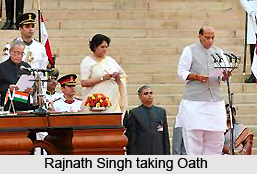 Rajnath Singh is an Indian politician hailing from Chandauli District of Uttar Pradesh. He is the current president of Bharatiya Janata Party and the Cabinet Minister of India.
Rajnath Singh is an Indian politician hailing from Chandauli District of Uttar Pradesh. He is the current president of Bharatiya Janata Party and the Cabinet Minister of India.
Rajnath Singh was born on 10th July 1951. He began his career as a lecturer in Physics and also he has the connection with Rashtriya Swayamsevak Sangh (RSS) from, the very early age. Later he was involved with Bharatiya Janata Party (BJP). The important political activities include Chief Minister of Uttar Pradesh, as a Cabinet Minister in the National Democratic Alliance administration and as twice elected National President of Bharatiya Janata Party. He was the President of the BJP youth wing before he became the President in BJP.
Early Life of Rajnath Singh
Rajnath Singh was born in the small village of Bhabhaura in the Chandauli district of Uttar Pradesh. Hailing from Rajput family, his father was Ram Badan Singh and his mother was Gujarati Devi. He was born into a family of farmers. But, with his great devotion to education, he went on to secure a Masters Degree in Physics from the Gorakhpur University.
Political Career of Rajnath Singh
Rajnath Singh was closely associated with the Rashtriya Swayamsevak Sangha (RSS) since 1964. From the age of 13, he was connected with RSS. Even during his employment tenure as a physics lecturer in Mirzapur, he had a good growth with RSS. In 1974, he was appointed as a Secretary of Bharatiya Jana Sangha in Mirzapur. In 1975 at the age of 24, Rajnath Singh was appointed as a District President of the Bharatiya Jana Sangha. In the year 1977, he was elected Member of Legislative Assembly (MLA) from the Mirzapur unit of Bharaitya Jana Sangha.
In the year 1984, he became the State President of the youth wing. Later in the year 1986, he was chosen as a National General Secretary of the youth wing of Bharatiya Jana Sangha. In the year 1988, he ultimately ascended to the position of National President in the BJP youth party and was also elected into the Uttar Pradesh Legislative Council.
Rajnath Singh became the Education Minister in the first BJP government in Uttar Pradesh in the year 1991. On 25 March 1997, he became the President of the BJP in Uttar Pradesh. In the year 1999, Rajnath Singh became the Union Cabinet Minister for Surface Transport. In the National Democratic Alliance (NDA) Government led by Atal Bihari Vajpayee, 10th Prime Minister of India, Rajnath Singh took the office as a Minister of Agriculture. Later he became the Chief Minister of Uttar Pradesh from 28 October 2000 to 8 March 2002. On 24 January 2013, following the resignation of Nitin Gadkari (former BJP President), Rajnath Singh was re-elected as the National President of BJP. Finally, in 2014 general election of India conducted by Election Commission of India, Rajnath Singh contested from the Lucknow Lok Sabha Seat. On May 16 2014, he was elected as Member of Parliament (MP) from the Lucknow constituency. He was sworn in as the Union Home Minister of India on 26th May 2014.






